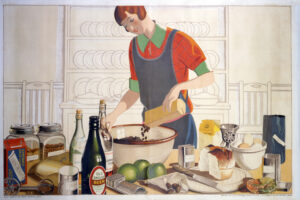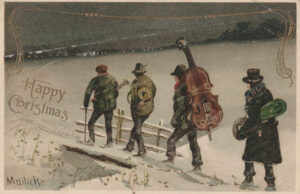
I’ve decided that I need to stop thinking it’s still September (it’s not) and just accept the fact that Hallowe’en has passed and Thanksgiving is but a few days away and we will very soon be well on our way toward Christmas. Even though I’ve spent the past two days at our pop-up shop at the Scandinavian Christmas Market in Lantana, the reality of the calendar has yet to make itself apparent in my head.
Ah, but today is Stir-Up Sunday. It is the last Sunday of ordinary time, the last Sunday before Advent begins (on November 30 this year)––Advent, of course, being our time of preparation for Christmas. I need to face reality. And, if you want to make traditional cakes and cookies for Christmas that need time to age and mellow in order to reach their best flavor (think Christmas puddings and boozy fruit cakes and even traditional German pfeffernüsse), well… this is the ideal day to make them. The timing is just right and it happens to coincide with the collect––the prayer after Communion in the Anglican Church, which today will go like this:
Stir up, we beseech thee, o Lord, the wills of thy faithful people;
that they, plenteously bringing forth the fruit of good works,
may of thee be plenteously rewarded; through Jesus Christ our Lord. Amen.
And whilst the minister is reading those words, those of us who are prone to wandering thoughts may be hearing these words instead:
Stir up, we beseech thee, the pudding in the pot;
Stir up, we beseech thee, and keep it all hot.
Slightly irreverent, perhaps, but our intentions are good: We just want to make Christmas extra special through things of this earth that we love, and surely the Lord would grant us that at Christmastime. A good fruitcake (and I mean a good one) requires a good four weeks to age and become sufficiently brandy-soaked to reach its best depth of flavor, as do steamed Christmas puddings.
Some of us would argue that it requires the four weeks of Advent for our Christmas celebration to be the best that it can be, too: four weeks to prepare and to make our houses as fair as are able. This is a concept we here at Convivio Bookworks are all for: We call it the Slow Christmas Movement. It focuses on the idea of taking time to savor each season as it comes: the four weeks of Advent being a time of preparation for the joy of Christmas that follows… and then allowing Christmastime itself to blossom and unfold and last its full season: Christmas Eve, Christmas Day, and all the Twelve Days of Christmas that follow, and if you really love Christmas, you might celebrate the ancient tradition we follow each year, keeping Christmas all the way to Candlemas Eve at the start of February.
But lo! I am getting ahead of myself. For now, let’s focus on today: Stir-Up Sunday. It is said that a good Christmas pudding should contain thirteen ingredients––one for Jesus and each of his disciples––no more and no less. And when it is prepared on Stir-Up Sunday, each member of the family should give the pudding a stir, making a wish as they do. The stirring must be from east to west: the same direction the Magi traveled to visit the newborn child.
Here is a recipe I’ve shared with you before: it is Nigella Lawson’s recipe for her Ultimate Christmas Pudding. You’ll find two versions presented there: one in metric measures and one in imperial measures. The two versions have more differences than just ways of measuring ingredients: The metric includes the British name for raisins (the lovely word sultanas), but it also lists suet as an ingredient, where in the American version, the suet is replaced by vegetable shortening. I won’t be making this pudding today, as it is the final day of that Scandinavian Christmas Market I mentioned earlier, but when I do, I’ll be making it using the shortening. Today may be the best day to make your puddings and fruitcakes, but I’m all for delaying if necessary, and for me this year, a delay is necessary.
l will also soon be dusting off music for the Advent season, which I think I love as much as Christmastime itself. I am, at heart, a guy who loves anticipation. Stir-Up Sunday and Advent? These things are right up my alley.
COME SEE US!
We’ve got several pop-up markets planned these next few weeks and we’d love to see you if you’re local!
One more day (today!) of the
SCANDINAVIAN CHRISTMAS MARKET
This lovely Christmas market began on Friday and ends today, Sunday November 23. It’s open today from noon to 6 PM and at our booth you will find our Swedish Christmas decorations and other imports of ours from Sweden, Iceland, and Finland, including Finnish tea and licorice, Icelandic chocolate, and Swedish saft, ginger snaps, licorice, and candy canes made by hand in the same Swedish candy shop where candy canes were first invented. Other vendors, too, plus AMAZING Finnish baked goods made on the premises. At Annan Maja at Finnish-American Village, 1800 South Drive, Lantana, Florida. (We’ve been having the best time there since the market began on Friday!)
Shop small with us this Thanksgiving Weekend: Friday November 28 through Sunday November 30
ADVENT & CHRISTMAS MARKET at the shop
We don’t keep regular hours at the shop, but we do open for special events, and this is our next one. Festive shopping, good music, good company, and homemade Christmas cookies while you shop, with our own Löfbergs Coffee from Sweden. Friday November 28 from 11 AM to 6 PM and Saturday & Sunday, November 29 & 30, from 11 AM to 4 PM.
Saturday December 6, Miami
MIAMI CHRISTMAS MARKET
We’ll have a huge pop-up shop filled with handmade artisan goods from Germany plus specialty foods, too, and our Advent candles and calendars. Saturday December 6 from 11 AM to 8 PM, indoors and outdoors (we’ll be indoors) at the German American Social Club in Miami, which is where we spent Oktoberfest this year. 11919 SW 56th Street, Miami.
Friday December 12, Lake Worth
KRAMPUSNACHT
On the Eve of St. Nicholas’ Day, it is Krampus who accompanies the good saint to scare girls and boys into good behavior, and he gets his own celebration at the American German Club in suburban Lake Worth (a little later than St. Nicholas’ Eve) on Friday evening, December 12, from 6 to 11 PM. We’ll be there with our biggest pop-up shop ever as this night ushers in the weekend’s Christkindlmarkt. Tickets required and must be purchased in advance. 5111 Lantana Road, Lake Worth.
Saturday & Sunday, December 13 & 14, Lake Worth
CHRISTKINDLMARKT
The annual Christkindlmarkt at the American German Club in suburban Lake Worth is just wonderful, and we’ll be there with our biggest pop-up shop ever, filled with German Christmas artisan goods plus more from Sweden and Mexico, as well as specialty foods and who knows what else! Tickets are required and must be purchased in advance. Usually sells out! Saturday December 13 from 1 to 9 PM and Sunday December 14 from 11 AM to 7 PM. 5111 Lantana Road, Lake Worth.
Image: “Making the Empire Christmas Pudding,” illustration by FC Harrison produced for the Empire Marketing Board, circa 1926–1939. [Public domain] by The National Archives UK via Wikimedia Commons.


